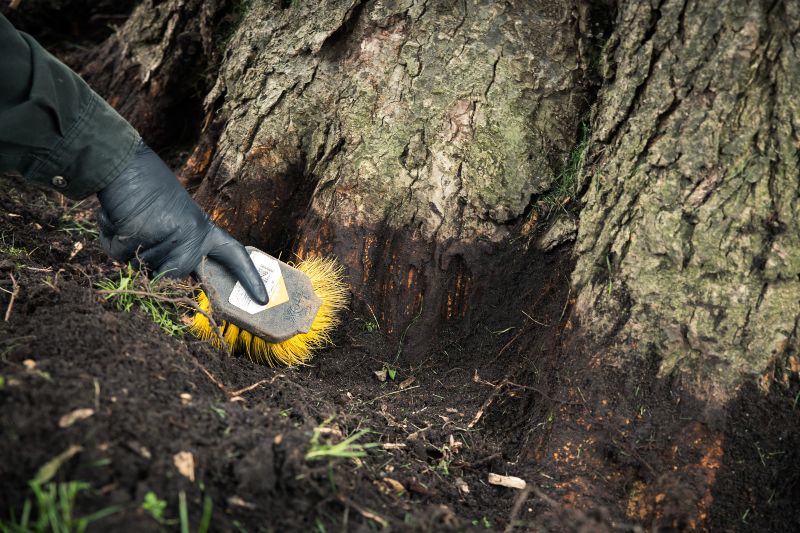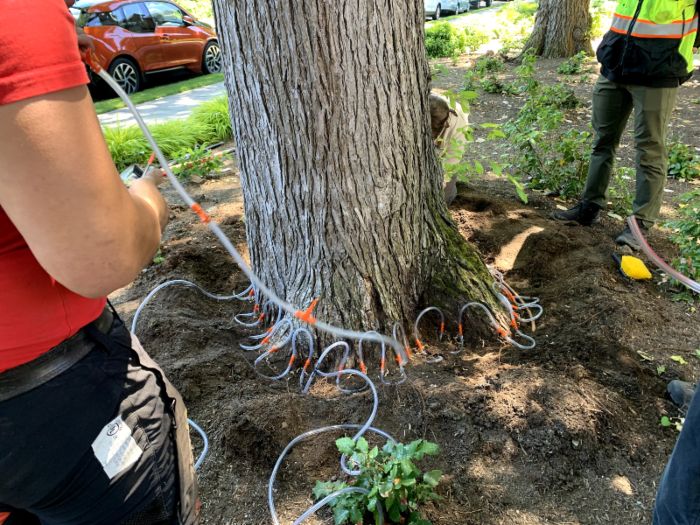Dutch Elm Disease (DED) is a devastating fungal infection that has wiped out millions of elm trees worldwide. It is a beetle-fungus disease complex caused by the Ophiostoma fungus and spread primarily by elm bark beetles. Unlike most tree diseases, DED can swiftly kill even healthy trees, making early detection especially crucial. Let us guide you through identifying and managing Dutch Elm Disease to help safeguard your majestic elm trees!
What Does a Dying Elm Tree Look Like?
Elm trees suffering from Dutch Elm Disease display several symptoms that indicate declining health. Initially, you might notice leaf wilting, starting at the branch tips and progressing inward. The leaves will turn yellow and curl, often appearing scorched or desiccated. This symptom is commonly known as “flagging,” where branches of a once lush tree suddenly look dried out and dead.
As the disease progresses, the canopy becomes increasingly sparse as leaves drop prematurely. Another telltale sign is the appearance of brown streaks or dark discoloration beneath the bark, particularly in the smaller branches. These streaks result from the tree’s response to the fungus, which clogs its vascular system, preventing water and nutrients from reaching the canopy. The overall decline of the tree is usually swift, and without intervention, a once healthy elm can die within a single growing season.
Can Dutch Elm Disease Spread to Other Trees?
Yes! Dutch Elm Disease is highly contagious and can spread rapidly to other elm trees through two primary pathways: beetle transmission and root grafting.
- Beetle Transmission: The most common method of spread is through elm bark beetles, which carry the fungal spores from infected trees to healthy ones. These beetles are attracted to weakened or dying trees, making them efficient vectors for the disease. They burrow into the bark, bringing fungal spores into contact with the tree’s vascular system.
- Root Grafting: The disease can also spread between trees through interconnected root systems. Elm trees planted close together may have roots that graft naturally, creating a direct pathway for the fungus to move from an infected tree to a healthy one. This method of spread is particularly dangerous because it can silently transmit the disease underground, going unnoticed until symptoms appear.
Signs of Dutch Elm Disease
- Leaf Wilt and Drop: The earliest sign is wilting in the upper canopy of the tree, often starting on one or two branches before spreading. Leaves may turn yellow, curl, and drop prematurely, which can create a sparse or thin canopy in the middle of the growing season.
- Brown Streaking in the Wood: If you peel back the bark of a dying branch, you may see brown streaks in the wood, a sign of the tree’s vascular system being blocked by the fungus. This streaking is diagnostic of Dutch Elm Disease and can help differentiate it from other diseases or stressors.
- Branch Dieback: Progressive dieback of branches is another sign of Dutch Elm Disease. The disease moves from the infected branches to the main stem, and as the tree’s vascular system becomes blocked, it can no longer support the canopy.
- Presence of Beetles and Galleries: The presence of elm bark beetles, or the small galleries they create under the bark, can also indicate an active infection. These beetles bore into the wood, leaving telltale patterns that suggest they’ve been feeding on the tree.

How to Manage Dutch Elm Disease?
- Prune and Remove Infected Branches: Early pruning of infected branches can sometimes save a tree if caught before the fungus reaches the main trunk. This method is only effective in the early stages and must be done with care to prevent further spread.
- Tree Removal: If the infection is severe, removing the entire tree is often best to prevent the disease from spreading to nearby elms. Properly dispose of infected wood, as beetles can still spread the fungus from cut branches.
- Fungicide Injections: Fungicide injections are a preventive and curative measure that can help protect high-value trees from infection. Effective fungicides include Arbotect 20-S, which protects the tree for up to three years.
- Sanitation: Properly disposing of infected wood and debris is critical. Elm bark beetles breed in dead and dying elm wood, so removing potential breeding sites can help reduce beetle populations and disease spread.
- Monitor Nearby Trees: Keep a close watch on nearby elm trees for early signs of infection, especially if a tree has recently been removed due to Dutch Elm Disease.

How to Protect Elm Trees From Dutch Elm Disease
- Regular Inspections: Conduct regular inspections of your elm trees, especially during the growing season, to catch any early signs of disease. Early detection provides the chance to intervene before it’s too late.
- Fungicide Treatments: Preventive fungicide injections can protect healthy trees from infection. These treatments should be applied by a qualified applicator and repeated according to professional recommendations.
- Avoid Pruning During Beetle Activity: Pruning elms during the active season for elm bark beetles (typically late spring to mid-summer) can attract beetles to fresh wounds, increasing the risk of infection. Instead, prune in late fall or winter when beetle activity is low.
- Plant Disease-Resistant Varieties: When planting new elms, consider choosing disease-resistant varieties that are less susceptible to Dutch Elm Disease. These trees have been specifically bred to withstand infection and can be a safer choice for the landscape.
By understanding the signs, management, and prevention of Dutch Elm Disease, you can help protect your elm trees and maintain the beauty and health of your urban forest!





